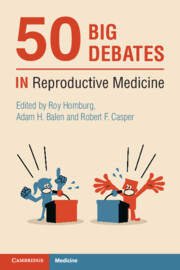Book contents
- 50 Big Debates in Reproductive Medicine
- Series page
- 50 Big Debates in Reproductive Medicine
- Copyright page
- Contents
- Contributors
- Foreword
- Introduction
- Section I Limits for IVF
- Section II IVF Add-ons
- Section III The Best Policy
- 14A IVF Should Be First-Line Treatment for Unexplained Infertility of Two Years Duration
- 14B IVF Should Be First-Line Treatment for Unexplained Infertility of Two Years Duration
- 15A Single Embryo Transfer Should Be Performed in All IVF Cycles
- 15B Single-Embryo Transfer Should Be Performed in All IVF Cycles
- 16A The Freezing of All Embryos Should Be Used for All IVF Cycles
- 16B The Freezing of All Embryos Should Be Used for All IVF Cycles
- 17A Luteal-Phase Support Should Be Stopped at the Time of a Positive Pregnancy Test
- 17B Luteal Phase Support Should Be Stopped at the Time of a Positive Pregnancy Test
- 18A A Natural Cycle Is the Best Protocol for Frozen Embryo Replacement
- 18B A Natural Cycle Is the Best Protocol for Frozen Embryo Replacement
- 19A All Pregnancies Conceived by IVF Should Be Delivered by Caesarean Section
- 19B All Pregnancies Conceived by IVF Should Be Delivered by Caesarean Section
- 20A Endometriosis Should Be Suppressed for 6–12 Weeks before Frozen Embryo Transfer
- 20B Endometriosis Should Be Suppressed for 6–12 Weeks before Frozen Embryo Transfer
- 21A Infertile Patients with Endometriosis Benefit from Surgery
- 21B Infertile Patients with Endometriosis Benefit from Surgery
- 22A Intramural Fibroids Greater than 4 cm in Diameter Should Be Removed to Aid Fertility
- 22B Intramural Fibroids Greater than 4 cm in Diameter Should Be Removed to Aid Fertility
- 23A All Infertile Women with a Uterine Septum Should Have a Surgical Removal
- 23B All Infertile Women with a Uterine Septum Should Have a Surgical Removal
- Section IV Embryology
- Section V Ethics and Statistics
- Section VI Male-factor Infertility
- Section VII Genetics
- Section VIII Ovarian Stimulation
- Section IX Hormones and the Environment
- Index
- References
14A - IVF Should Be First-Line Treatment for Unexplained Infertility of Two Years Duration
For
from Section III - The Best Policy
Published online by Cambridge University Press: 25 November 2021
- 50 Big Debates in Reproductive Medicine
- Series page
- 50 Big Debates in Reproductive Medicine
- Copyright page
- Contents
- Contributors
- Foreword
- Introduction
- Section I Limits for IVF
- Section II IVF Add-ons
- Section III The Best Policy
- 14A IVF Should Be First-Line Treatment for Unexplained Infertility of Two Years Duration
- 14B IVF Should Be First-Line Treatment for Unexplained Infertility of Two Years Duration
- 15A Single Embryo Transfer Should Be Performed in All IVF Cycles
- 15B Single-Embryo Transfer Should Be Performed in All IVF Cycles
- 16A The Freezing of All Embryos Should Be Used for All IVF Cycles
- 16B The Freezing of All Embryos Should Be Used for All IVF Cycles
- 17A Luteal-Phase Support Should Be Stopped at the Time of a Positive Pregnancy Test
- 17B Luteal Phase Support Should Be Stopped at the Time of a Positive Pregnancy Test
- 18A A Natural Cycle Is the Best Protocol for Frozen Embryo Replacement
- 18B A Natural Cycle Is the Best Protocol for Frozen Embryo Replacement
- 19A All Pregnancies Conceived by IVF Should Be Delivered by Caesarean Section
- 19B All Pregnancies Conceived by IVF Should Be Delivered by Caesarean Section
- 20A Endometriosis Should Be Suppressed for 6–12 Weeks before Frozen Embryo Transfer
- 20B Endometriosis Should Be Suppressed for 6–12 Weeks before Frozen Embryo Transfer
- 21A Infertile Patients with Endometriosis Benefit from Surgery
- 21B Infertile Patients with Endometriosis Benefit from Surgery
- 22A Intramural Fibroids Greater than 4 cm in Diameter Should Be Removed to Aid Fertility
- 22B Intramural Fibroids Greater than 4 cm in Diameter Should Be Removed to Aid Fertility
- 23A All Infertile Women with a Uterine Septum Should Have a Surgical Removal
- 23B All Infertile Women with a Uterine Septum Should Have a Surgical Removal
- Section IV Embryology
- Section V Ethics and Statistics
- Section VI Male-factor Infertility
- Section VII Genetics
- Section VIII Ovarian Stimulation
- Section IX Hormones and the Environment
- Index
- References
Summary
Most women conceive within the first 12 months of regular unprotected sexual intercourse. Of the 16% that don’t, around half will conceive without treatment during months 12 to 24 [1]. During those first two years of trying the couple should undergo investigations including semen analysis and confirmation of ovulation and tubal patency (by HyCoSy, HSG or laparoscopy). If all tests return as normal then, by definition, the couple have ‘unexplained’ infertility. Impatience by doctor or patient to ‘do something’ can lead to the use of unnecessary interventions such as ovarian stimulation (OS) (for ovulating women?!) and/or intra-uterine insemination (IUI) (for couples with a normal reproductive tract and sperm function?!) as these are often viewed as softer, more natural treatments. But these are certainly not as natural (or as cheap) as conceiving naturally. A number of studies comparing outcomes of OS or OS-IUI versus IVF to ‘treat’ couples with unexplained infertility unfortunately include patients with 12 to 24 months of trying [2]. Unsurprisingly the OS or OS-IUI success rates are high (and therefore falsely close to IVF). I say unsurprising as the woman was likely to conceive anyway even without OS and/or IUI. For couples with less than 2 years of unexplained infertility, full investigation but no treatment is required.
- Type
- Chapter
- Information
- 50 Big Debates in Reproductive Medicine , pp. 74 - 75Publisher: Cambridge University PressPrint publication year: 2021

